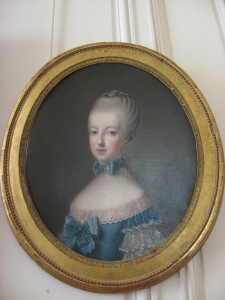I spent some time studying in London a few years ago, and it was my pleasure, among other things, to have an art history class that included weekly visits to the many, wonderfu l galleries in London. Among numerous different great works of art from many eras, a few stood out to me. They were almost invariably from the 18th century, the time of the Affair of the Diamond Necklace (‘m drawn to the aesthetic of the era). Some of my favorites include An Experiment on a Bird in the Air Pump (right, by Reynolds) and A Rake’s Progress (Hogarth). I didn’t see any in London, but I also love practically everything by Vigée-Le Brun. The paintings of the time are endlessly elegant, engaging, and (often) humorous.
l galleries in London. Among numerous different great works of art from many eras, a few stood out to me. They were almost invariably from the 18th century, the time of the Affair of the Diamond Necklace (‘m drawn to the aesthetic of the era). Some of my favorites include An Experiment on a Bird in the Air Pump (right, by Reynolds) and A Rake’s Progress (Hogarth). I didn’t see any in London, but I also love practically everything by Vigée-Le Brun. The paintings of the time are endlessly elegant, engaging, and (often) humorous.
I was struck by the beauty and solemnity of The Morning Walk, or Mr. and Mrs.William Hallett, by Gainsborough in the National Gallery. Amongst the many aesthetically pleasing paintings, this one stood out to me. It’s beauty comes from the ethereal treatment of the setting, the dress, and the dog. The lady’s light, ephemeral dress and wrap dissolve into the background and into each other. The tones are muted, the background washed into tans, olive greens, and stormy blues. And, most intriguing to me, the brush strokes are fairly loose, leaving the impression of a world that is only three-quarters formed. It is reminiscent of the Impressionists, and that’s a good thing because I love Impressionists. It’s a departure from much of the artwork of the period, which was often painstakingly realistic.
I wanted some version of this painting for my wall but balked at the idea of getting an expensive print. Being rather more artistically talented than average (not to toot my horn too much–I’m no master), I decided to try my hand at reproducing the painting. I’m not particularly good with paints, and besides I don’t currently have a very good space to paint in. However, given the mistiness of the original work, and given the always-airy effect of chalk pastel, I settled on chalk pastels.
It wasn’t, perhaps, the best choice. Chalk pastel is incredibly, incredibly smudgy. I’m very careful about where I put my hands and fingers when I work, but even so it was impossible to keep things tidy. And the effects I was going for really do lend themselves much better to paint than pastels. I had a hell of a time getting the pastels to cooperate. At least once, I had to get out an exacto knife and scrape away the pastel and a layer of the board I was working on. I needed to add more white, but I wasn’t able to color over or erase what was already there. That board was black; I attempted to start with a green board, thinking it would be the best color to start with. I quickly found that there was far too much black in the background for me to begin with any other color.
When I get frustrated, I get lazy, so this picture sat for months as I gave it distrustful, sidelong glances and wondered why it didn’t just finish itself. Once I set to, though, it really wasn’t all that bad. I finally finished it a few weeks ago. The most frustrating part of the whole process, perhaps, is that my attempts to fix the chalk pastel in place with spray fixative failed. Something about the board I used, I think, made it so the pastel won’t stick. So all that hard work isn’t even fixed in place. One wrong finger, and it’ll be smudged all to hell. I’ve put it behind glass in a frame in hopes of protecting it. I suspect a lot of the pastel will come off onto the glass, but at least it won’t get ruined by accident.
On the upside, I still have my pencil-and-paper outline. I’m better at pencil than at pastels, so I can still (some day) make a lovely black-and-white pencil rendition of The Morning Walk. Heck, I could even transfer the outline to canvas and give the paint thing a go . . .
Anyway, here are a few images of the original painting and my drawing of it in stages.






